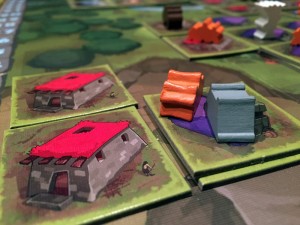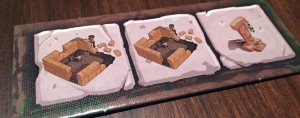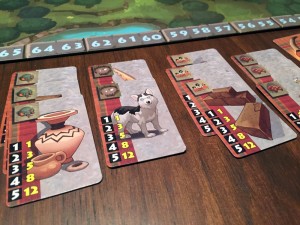 Tile placement is a fairly common (and fairly popular) mechanic in modern board games. It’s a simple-to-grasp concept, and in the right game can offer a wealth of strategic choices to the player. Some of the most well-known games using this mechanic are titles such as: Carcassonne, Alhambra, Vikings, Walnut Grove, Keyflower and Suburbia. These games also happen to be some of my all-time personal favorites.
Tile placement is a fairly common (and fairly popular) mechanic in modern board games. It’s a simple-to-grasp concept, and in the right game can offer a wealth of strategic choices to the player. Some of the most well-known games using this mechanic are titles such as: Carcassonne, Alhambra, Vikings, Walnut Grove, Keyflower and Suburbia. These games also happen to be some of my all-time personal favorites.
When I learned about the Kickstarter campaign for the release of a game called Hoyuk, which also uses tile placement as its main mechanic, I was instantly interested. I was also cautious about becoming a backer too quickly. As much as I enjoy tile placement games, I wondered if Hoyuk would bring anything else new and exciting to the table. I ultimately decided to take a chance and back the project. Was my money well spent? Read on, and I’ll let you know how the game plays, and some of my thoughts about it.
Hoyuk is a tile placement/area majority/set collection game, designed by Pierre Canuel. It supports 2 to 5 players and plays in about 60 minutes.
Game Overview:
In Hoyuk, players represent clans attempting to settle villages with other clans (opponents) in the land of Anatolia (modern-day Turkey) during the Neolithic period. (Side note: “Hoyuk” is an ancient Turkish word meaning “hill”, “mound”, or “settlement”.) Tiles representing houses will be placed on the board by each player, with the goal of increasing their families’ presence within each block (contiguous group) of houses. They can also improve their houses by adding features to them such as ovens, shrines, and animal pens.
At the end of each round, each block will be evaluated for majorities in a number of different aspects, and the player having the majority in each aspect will earn cards that can be used later to gain additional elements for their houses or to gain victory points. After the round in which one of the players builds his entire supply of houses, the game ends and the player with the most victory points is the winner.
Game Components:

Hoyuk is chock-full of components, many of them appearing in an upgraded version from the Kickstarter campaign. A large, colorfully illustrated board is used for tile placement, and also to hold many of the other game components. There are tiles for the players’ houses (25 per player), for the animal pens, and for determining construction on each turn. Two sets of cards are used: one for the aspect scoring/set collection phase of the game, and another which is used to determine random events, or “catastrophes”, that will effect players in each round. Lastly, there are several sets of custom-shaped wooden bits to represent the ovens, shrines, villagers, and cattle.
How to Play:
Each player receives one set of house tiles for their clan. The wooden bits are all placed on their respective storage areas on one side of the board, and the aspect cards, catastrophe cards, and construction tiles are shuffled and placed in separate stacks on the other side of the board. When setting up the cards and construction tiles, you will use more or less of them, depending on whether you are playing the “basic”, “medium”, or “advanced” game. Once a starting player is determined, the game begins. Each round of the game contains 4 phases: construction, catastrophes, aspect cards, and cleanup.

In the construction phase, each player is dealt two construction tiles, one at a time, which displays 3 elements that can be built. Players place the 3 elements shown on their tile onto the board (if able). These are usually house tiles, but can also be ovens, shrines or pens (as well as villagers or cattle, if playing the advanced game).
House tiles can be placed almost anywhere on the board: 1) by themselves (i.e., not adjacent to any other tiles) to start a new block, 2) adjacent to one of their already-built houses, or 3) adjacent to another player’s house (if they don’t already have houses in that block). A second story can be added to a house by placing another house tile on top of an existing one. Pens are built adjacent to a player’s house tile, and the other elements (oven, shrines, etc.) are placed on top of house tiles. A group of adjacent houses of the same color is called a family, and a group of all adjacent houses (regardless of color) and pens are known as a block.
In the catastrophe phase, a catastrophe card is drawn and the effect may force players to lose some of their houses. When this happens, a house tile is turned over to show the ruined side, and this site may be built over later in the game by any player. Other catastrophes may affect elements or pens as well.

In the aspect phase, each block is evaluated, one by one, for majorities in ovens, shrines, and pens. (In the medium game, the number and height of houses are checked for majority, and in the advanced game, villagers and cattle are also added to the aspects that are evaluated.) A second story on a house is used as a tie-breaker. The player with majority in each of these elements (per block) is allowed to take the top aspect card from the stack in front of the corresponding aspect symbol. These cards can be turned in later (at the beginning of each phase) to build the element shown on it, or can be saved in order to collect sets of cards with matching elements. When a set is turned in, the player receives a number of victory points determined by the amount of cards turned in.
At the end of the round, all aspect cards used by players during the round are returned to a stack of each player’s choice, and the person with the first player marker decides who will be the first player in the next round.
When a player builds his final house tile, that round is played to completion and then the game ends. Unplayed aspect cards are worth 1 victory point each, and then the player with the largest family in each block receives 1 victory point per house they have in that block. The player with the most victory points is the winner.

Game experience:
On the surface, this game doesn’t seem like it would be that complicated. Place your house tiles on the board, add stuff to them, collect cards, earn points. But once my first game got going, I quickly realized that there were many strategic choices to be made, several things to be watching closely all at the same time and it required a lot of thinking ahead to future turns. At the beginning of the game, the players always seem to be playing catch up with each other, to try to get (and maintain) majorities of the houses and other elements. But later in the game, as the landscape grows, and more and more blocks start to be added to the board, you just can’t stay in control of everything. This is frustrating – but a good kind of frustrating, since you know that every other player is going through the same thought process.

One of the basic rules not yet mentioned is that in order for a block to be evaluated in the aspect phase, there must be at least 2 different families in it. So while it’s usually a good idea to start expanding your houses into new blocks, those houses won’t earn anything unless the other players start moving their families into that block. The rules mention that it’s important for players to negotiate with one another regarding building into a newly started block, but in the games I’ve played, we didn’t see that happening. It was more or less just understood that your chances of earning aspect cards would only increase if you built into each other’s blocks.
As with any game that includes random events, the catastrophe cards throw a bit of uncertainty and possible chaos into the game. There are a wide variety of them, and they are all nasty to some degree (hence the name catastrophe!) It is possible that one or two of the catastrophe cards will have no effect, depending on the state of the board at the time they are drawn, but usually someone will be effected. If you are lucky, you may only have to dismantle one item: a house, pen, oven, etc. But sometimes, a catastrophe will force affected players to dismantle HALF of those items in a given block. This can be devastating, but for the most part when this happens, it will usually happen to more than one player at a time. In my opinion, this is more of that good frustration.
The entire idea of the aspect cards – how they are earned, how they can be used, and how they are placed back on the board – is an interesting and very clever one. I like how they can be used at just the right time (right before aspect evaluation) to add an element to the board to wrestle control of an aspect from another player. On the other hand, you might not want to use too many cards that way, since collecting matching sets of cards is the primary way to earn points in the game. On the OTHER other hand, hoarding a lot of cards might not be the best thing either, especially if most or all players are doing that. Here’s why: When players use their cards (either for building an element, or turning in sets for points), the used cards are temporarily set aside. As mentioned earlier, during the end of round phase, players will then return their used cards to stacks on the board. However, all of a player’s cards must be returned to the same stack. The brilliant part of this whole process is that if any of the stacks of cards ever become empty, that stack CANNOT be replenished. What this means is that the aspect associated with an empty stack will never be evaluated again for the rest of the game.

For example, if you have a lot of ovens on the board, and the oven stack of aspect cards becomes empty, you will not earn any additional cards for your ovens for the rest of the game. It is therefore crucial to keep a close watch on the amount of cards remaining in each stack during the game, and not let any of them go empty. Unless, of course, it’s a stack associated with an aspect that one of your opponents is focusing on. This seems to be even more critical in games with more players, since there is a greater chance of one (or more) of the stacks becoming empty. In one of our games, there were only 2 stacks left, of the possible 7 total, that had cards in them toward the end of the game, so only 2 aspects were being evaluated each round. I think that’s a mistake none of us will ever make again!
According to the rules, Hoyuk was designed with 3 game levels: basic, medium, and advanced. The basic game only evaluates 3 different aspects: ovens, shrines, and pens. When playing the medium game, there are 2 additional aspects added: number of houses and height of houses. In the advanced game, 2 final aspects (and their wooden bits) are added: villagers (placed on houses), and cattle (placed in pens). Also, a figure called the Shaman is added, which appears on certain construction tiles. He protects blocks from catastrophe cards. Our gaming group only played the basic game once, and since it was pretty easy to grasp those rules, we moved directly into the advanced version on our second play with no problems. (One of the players in that advanced game had never played the game at all before, and she picked up the advanced version pretty easily). If your group has any sort of modern board gaming experience, I would suggest a similar procedure: play the first game in basic mode to get used to the rules and mechanics, and you should have no difficulties moving right into the advanced mode. It adds so much more to the game, and it’s definitely a richer experience.

Speaking of that advanced mode, there is one part of it that our group didn’t like at all. As part of the theme of the game, each of the 5 colors of playing pieces are assigned a clan name, and there is a little background flavor story for each of them. Along with that, when playing the advanced game, each clan has a certain power, or ability, that can be triggered whenever a player collects and turns in 5 matching icons (and gains the respective 12 points). These powers are unbalanced. Like, REALLY unbalanced. 3 of them let a player collect a few bonus elements, and place them on the board, which is fine. Another one lets you steal 2 elements of your choice (except houses) from another player, which is somewhat nasty and can tip the majority scales if sprung at the right (wrong?) time. However, the final clan power lets a player destroy any 1 house of another player (along with any elements on it), and replace it with a house of his own at that same spot. This power is crazy unbalanced and can be devastating to the unfortunate player on the receiving end. When we started our first advanced game, we chose our player colors by preference (as is usually done in a game), and only then did we find out what power was associated with each particular color. By the end of the game, we had all agreed that this was probably not the best way to distribute powers, especially since they are so lopsided. If the designer can create a revised set of powers that are more balanced, we would have no problem including them in future games, but as it is, we most likely will not be using the clan powers.
Final Thoughts:
Happily, the unbalanced clan powers are only a minor glitch in an otherwise a really fun game, and I wouldn’t let that stop anyone from adding it to their collection. It’s the simplicity of the rules and the quickly escalating scope of the game that grabbed me, and I had a lot of fun with each play. You need to have your eyes everywhere: all over the board, on the dwindling stacks of aspect cards, on which aspect cards (and how many) each opponent has, and on the number of houses each opponent has left to build. On top of that, you need to try to plan one or two turns ahead, all the while remembering that a catastrophe can come along at any time and literally lay waste to your plans. Some tile placement games, like the classic Carcassonne, are somewhat “peaceful”, and there’s nothing wrong with that. Hoyuk, however, is definitely more tense, nasty, and chaotic, and I wouldn’t have it any other way.
If you’d like to try Hoyuk for yourself, you can pick up a copy for about $55.
Final Scores: 3.5 stars – Don’t let the simple rules fool you: this one is definitely on the higher end of strategic scale, as far as tile placement games go. Lots to think about at all times, including planning ahead and trying to anticipate what your opponents will do on their turns.
 Hits:
Hits:
• Easy rules
• Solid components and pleasing artwork
• Really fun escalation and tug-of-war mechanics
Misses:
• The unbalanced clan powers.























